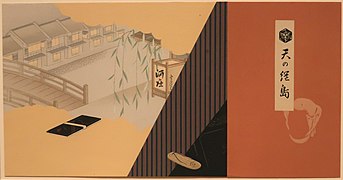Kojima Gyokuhō
Kojima Gyokuhō (児嶋 玉鳳, 1907–1934) was a Japanese artist. Little is known about him, except that he worked with the Kyoto City publisher Happōdō.[1] He rejected the Western concept that art was an expression of the artist's individuality. Rather, he embraced the traditional method of producing woodblock prints through the cooperation of a designer (artist), a woodblock carver, a printer, and a publisher.[2][3] He also favored traditional Japanese subjects, such as Japanese textiles, kabuki, and ukiyo-e masterpieces.[4]
Prints
[edit]Kojima is best known for his series One Hundred Poetry Illustrations. It consists of 50 woodblock prints. Each print is about a traditional Japanese poem. The series were published by Kondo Happodo in Kyoto in 1932. For the prints he used metallic pigments, gofun, and embossing.[5]
Gallery
[edit]- One Hundred Poetry Illustrations: A Collection of Multicolor Woodblock Prints by Kojima Gyokuhō, c.1934
-
Asagao Nikki
-
Kanjincho
-
Kasane Ogi
-
Kibun Daijin
-
Michitose
-
Nozaki Mura
-
Ohancho
-
Onatsu Kyoran
-
Sanja Matsuri
-
Sugawara Denju Tenarai Kagami
-
Sukeroku
-
Ten no Amijima
-
Yodo no Kawase
References
[edit]- ^ Honolulu Museum of Art
- ^ Honolulu Museum of Art, wall label for The Graphic Design of Kojima Gyokuhō, January 10, 2019 - March 10, 2019
- ^ Michener, James A., The Floating World, Random House, New York, 1954, p. 148
- ^ Honolulu Museum of Art, wall label for The Graphic Design of Kojima Gyokuhō, January 10, 2019 - March 10, 2019
- ^ "Original woodblock prints bound in two albums - Published by Kondo Happodo (50) - Cardboard, Mulberry paper - Kojima Gyokuhō 児嶋玉鳳 (1907-1934) - "Utae hyakuban" 歌絵百番 (One Hundred Poems) vol 1 (parts I & II) - Japan - 1932". LOT-ART. Retrieved 21 December 2021.














